Road Safety Data
Road Safety Data concern the most recent tables and figures on road crashes, risk exposure and performance indicators in Greece, in Europe and worldwide gathered from various Greek and International data sources like the European Commission, ELSTAT, CARE, Eurostat, IRTAD, NTUA, etc.

About the Greek road safety data ![]()
| INTERNATIONAL
i-SafeModels Global Road Safety Platform |
|
| Road Crashes | Behaviour |
| Risk Exposure | Other |
| Performance Indicators | |
About the International road safety data ![]()
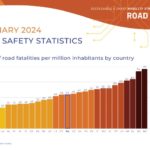
According to the European Commission preliminary statistics, fewer people died on European roads in 2024, a slight 3% drop compared to 2023, which is the equivalent to 600 fewer lives lost. In 2024, around 19,800 people were killed in road crashes in the EU. Over the past five years, Greece, Spain, France, and Italy have seen only modest declines in road deaths; in contrast, Bulgaria, Denmark, Lithuania, Poland, and Slovenia are making strong progress toward the 50% reduction target. Even if road fatalities decreased more significantly in 2024 than they did in 2023, the overall pace of improvement remains too slow, and most Member States are not on track to meet the EU’s goal of halving road deaths by 2030. 
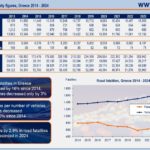
Road fatalities in Greece in 2024 presented a slight increase (3%) compared to 2023 figures, according to the provisional ELSTAT data, bringing Greece at the 25th position out of 27 EU countries (better only than Bulgaria and Romania). These results demonstrate that Greece is well out of track to achieve the targets set neither for 2025 (-25%) nor for 2030 (-50%) and highlight that there is an urgent need for extra effort to further improve road safety in the Greek roads, with systematic actions from the Authorities and serious engagement from the society. 


The Directorate General for Mobility and Transport (DG Move) of the European Commission released the Statistical Pocketbook 2024 “EU Transport in figures”. In this Statistical Pocketbook, key road safety Tables are contained, together with several other Tables on transport statistics, providing a complete picture of current trends in transport in Europe. Data on road fatalities for the EU Member States and associate countries allow for time series comparisons and country rankings. 

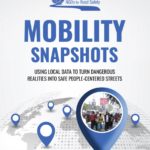
The Global Alliance of NGOs for Road Safety recently launched their mobility snapshot tool, an interactive map which shows the realities of how unsafe the streets are as well as the solutions that can make the communities more livable and sustainable, enabling access to education and work. Data are collected at specific intersections in local communities from 118 Mobility Snapshots in 44 countries at intersections across Africa, Asia, Australasia, Europe, and North and South America. Key findings show that more than 156,000 pedestrians use these 118 intersections during peak hour, yet 102 of them lacked traffic calming measures or a speed limit of 30 km/h or lower. 


Comune di Bologna has recently published a Report on the first year of implementing the 30 km/h speed limit in the city, which has the main objective of the improvement of road safety and the increase of sustainable mobility. This Report showed that for the first time since 1991, no pedestrians were killed, and road deaths were reduced by 50%. Also, crashes were reduced by 13% and urban traffic pollution by 30%. Finally, the report indicated that there has been a significant increase in bicycle flows by 10%, as well as the use of car and bike sharing services. 

Fruitful discussions with NTUA Professor George Yannis, Deputy Mayor for Ecological Transition, Ana Lisa Boni and Deputy Mayor for Sports, Luca Bellinato took recently place, demonstrating the need to intensify efforts for lower speeds and safer roads everywhere and for all.
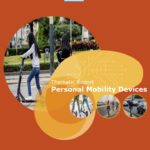
The European Commission with the active contribution of NTUA, SWOV, VIAS Institute and KFV has published at the European Road Safety Observatory, the Personal Mobility Devices Thematic Report which mainly refers to the safety of electric scooters. This Thematic Report highlights that a high proportion of crashes with a PMD are caused by falls, that can lead to common head injuries and by increasing helmet use would prevent these injuries. Moreover, a series of specific countermeasures are suggested, such as an e-scooters ban from pavements, a lower 30 km/h limit in urban areas and training motor vehicle users to be prepared to interact with PMDs is equally important for micro-mobility safety. 

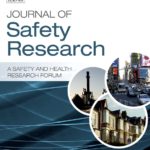
A paper titled Explainable macroscopic and microscopic influences of COVID-19 on naturalistic driver aggressiveness derived from telematics through SHAP values of SVM and XGBoost algorithms authored by Apostolos Ziakopoulos, Marios Sekadakis, Christos Katrakazas, Marianthi Kallidoni, Eva Michelaraki and George Yannis has been published in Journal of Safety Research. This study aims to quantify the impacts of the COVID-19 pandemic on driver behavior as expressed by harsh accelerations (HA) measured from over 35,5000 naturalistic driving trips by smartphone telematics data using advanced machine learning algorithms, including SVM and XGBoost, combined with SHAP values. Key findings indicate that high speeding, total trip distance, and trip duration are associated with increased HA counts. Drivers perform more HAs on speeds between 30–50 km/h, while after 50 km/h, the contributions of speed lead to fewer HAs. 

The International Transport Forum (ITF) has recently published a new Report titled “Measuring New Mobility: Case Studies and Best Practices“. The Report features case studies from various countries, focusing on new mobility services such as ride-sharing, micro-mobility, and autonomous vehicles. Key findings emphasize the importance of robust data collection and analysis methods to assess the safety, efficiency, and environmental impacts of these services. The report provides recommendations for policymakers to design effective frameworks for integrating new mobility into existing transport systems. 


Τhe European Transport Safety Council (ETSC) has published the 47th PIN Flash Report titled “Improving Road Safety of E-scooters“. This Report calls for the development of mandatory technical requirements for all e-scooters sold in the European Union, highlighting the need for stronger road safety measures across Europe. Key recommendations include stricter e-scooter safety standards, such as a 20 km/h speed limit, to address rising urban safety concerns. Enhanced regulations aim to ensure safer roads for all users. 


The European Transport Safety Council (ETSC) has published a Position Paper titled “EU Multiannual Financial Framework 2028-2034 Funds for Road Safety“. In this paper, ETSC presents recommendations for funding for road safety initiatives within the next long-term EU budget, known as the Multiannual Financial Framework (MFF). These recommendations should support work towards meeting EU’s Vision Zero target of reducing road deaths and serious injuries by 50% by 2030, paving the way for safer roads across Europe. 


The European Union Road Federation (ERF) has released the Road Statistics Yearbook 2024”. As for many years, this publication provides the road community with important updated information on road transport sector and road infrastructure in Europe and beyond as an essential key element of the global mobility with one section focusing on road safety. 

The European Commission published the latest figures on Road safety in the EU, showing that 20,400 people were killed in road crashes in 2023, a 1% decrease in relation to 2022. While the underlying long-term trend is downward (-10% compared to 2019), the current pace of decline falls short of the required 4.5% annual reduction needed to achieve the EU’s goal of halving road deaths by 2030. Preliminary figures for the first six months of 2024 indicate the number of deaths on EU roads has remained the same, compared with the same period in 2023. 
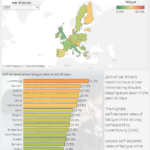
According to the E-Survey of Road Users’ Safety Attitudes (ESRA3) results, 21% of car drivers report to have driven while having trouble keeping eyes open in the past 30 days. The highest self-declared rates of fatigue while driving correspond to Luxembourg (31%), while the lowest are recorded in the United Kingdom (13%). 

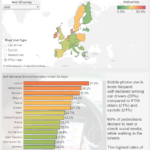
According to the E-Survey of Road Users’ Safety Attitudes (ESRA3) results, mobile phone use is more frequent self-declared among car drivers (28%) compared to PTW riders (21%) and cyclists (21%). Furthermore, 69% of pedestrians declare to text or check social media, while walking in the streets, while the highest rates of mobile phone use for car drivers are found in Luxembourg (41%). 

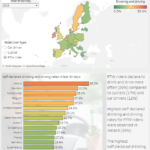
According to the E-Survey of Road Users’ Safety Attitudes (ESRA3) results, PTW riders declare to drink and drive more often (20%) compared to cyclists (17%) and car drivers (12%). The highest self-declared drinking and driving rates for PTW riders were observed in Ireland (36%), while the highest respective rates for car drivers were recorded in Luxembourg (24%). 

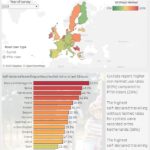
According to the E-Survey of Road Users’ Safety Attitudes (ESRA3) results, cyclists report higher non-helmet use rates (63%) compared to PTW riders (29%). The highest self-declared travelling without helmet rates for cyclists were recorded in the Netherlands (88%), while the highest respective rates for PTW riders were observed in Bosnia and Herzegovina (52%). 

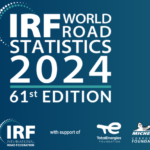
The International Road Federation (IRF) released the 61th edition of the IRF World Road Statistics 2024 (WRS2024), with data now open to all for free through the IRF WRS Data Warehouse platform, thanks to the generous support of the TotalEnergies Foundation and Michelin Corporate Foundation. The IRF WRS 2024 continues to be the major comprehensive, universal source of statistical data on road networks, traffic and inland transport, including traffic crashes. This year the WRS 2024 includes the latest data covering years 2017 to 2022, with the active contribution of NTUA for the Greek data. It includes over 200 road and transport-sector related indicators across 11 sections, covering more than 200 countries and territories. 

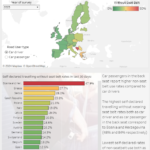
According to the E-Survey of Road Users’ Safety Attitudes (ESRA3) results, car passengers in the back seat report higher non-seat belt use rates compared to car drivers. The highest self-declared travelling without wearing seat belt rates both as car driver and as car passenger in the back seat correspond to Bosnia and Herzegovina (48% and 84% respectively), while the lowest self-declared rates of non-seatbelt use both as a car driver and as a car passenger were observed in Luxembourg (5% and 16% respectively). 

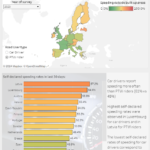
According to the E-Survey of Road Users’ Safety Attitudes (ESRA3) results, car drivers report speeding more often (61%) than PTW riders (45%). The highest self-declared speeding rates were observed in Luxembourg for car drivers and in Latvia for PTW riders, while the lowest self-declared rates of speeding for car drivers correspond to the United Kingdom (40%) and for PTW riders to France (25%). 

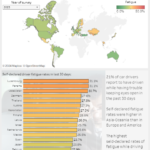
According to the E-Survey of Road Users’ Safety Attitudes (ESRA3) results, 21% of car drivers report to have driven while having trouble keeping eyes open in the past 30 days. Self-declared fatigue rates were higher in Asia-Oceania than in Europe and America. Moreover, the highest self-declared rates of fatigue while driving correspond to Luxembourg and Panama (31%). 

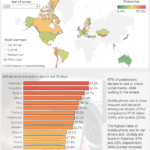
According to the E-Survey of Road Users’ Safety Attitudes (ESRA3) results, 67% of pedestrians declare to text or check social media while walking in the streets. Mobile phone use is more frequent self-declared among car drivers (31%) compared to PTW riders (23%) and cyclists (23%). Furthermore, the highest rates of mobile phone use for car drivers and cyclists are found in America (31% and 23% respectively), while Europe recorded the highest rates for pedestrians (64%) and Asia-Oceania for PTW riders (25%). 

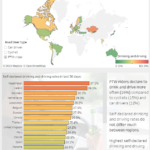
According to the E-Survey of Road Users’ Safety Attitudes (ESRA3) results, self-declared drinking and driving rates do not differ much between regions. More precisely, PTW riders declare to drink and drive more often (19%) compared to cyclists (15%) and car drivers (12%). Moreover, the highest self-declared drinking and driving rates for PTW riders were observed in Kazakhstan (37%). 

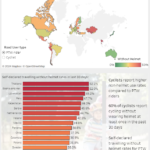
According to the E-Survey of Road Users’ Safety Attitudes (ESRA3) results, cyclists report higher non-helmet use rates compared to PTW riders, with 60% of cyclists reporting cycling without wearing helmet at least once in the past 30 days. Furthermore, self-declared travelling without helmet rates for PTW riders are generally lower in European and American compared to Asia-Oceanian countries. 

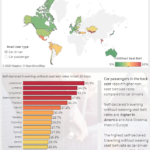
According to the E-Survey of Road Users’ Safety Attitudes (ESRA3) results, car passengers in the back seat report higher non-seat belt use rates compared to car drivers. Furthermore, self-declared travelling without wearing seat belt rates are higher in America and Asia-Oceania than in Europe. It is remarkable that the highest self-declared travelling without wearing seat belt rate as car driver corresponds to Uzbekistan (61%) and as car passenger in the back seat to Kyrgyzstan (94%). 

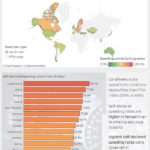
According to the Ε-Survey of Road Users’ Safety Attitudes (ESRA3) results, car drivers (53%) state speed limit violations more often than PTW riders (43%). Self-declared speeding rates are higher in Europe than in America and Asia-Oceania. It is remarkable that the highest self-declared speeding rates were observed in Luxembourg for car drivers and in Latvia for PTW riders. 

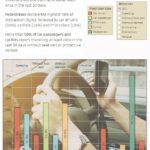
According to the European Survey of Road Users’ Safety Attitudes (ESRA3) results, 52% of total car drivers state speed limit violations outside built-up areas at least once in the last 30 days. Pedestrians declare the highest rate of distraction (81%), followed by car drivers (33%), cyclists (19%) and PTW riders (16%). Remarkable is that more than 50% of car passengers and cyclists report travelling at least once in the last 30 days without seat belt or protective helmet. 

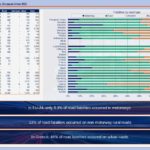
The new EU road fatalities by area and road type table of the NTUA Road Safety Observatory, based on European Commission CARE data for 2022, provides an overall view of the distribution of fatalities between the different road types. According to this table, only 9.3% of road fatalities in EU-24 occurred in motorways and 53% of road fatalities occurred on non motorway rural roads. 
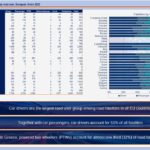
The new EU road fatalities by road user type table of the NTUA Road Safety Observatory, based on European Commission CARE data for 2022, provides an overall view of the distribution of fatalities between the different road users. It can be clearly observed that car drivers are the largest road user group among road fatalities in all EU countries. Furthermore, together with car passengers, car drivers account for 53% of all fatalities. 

According to the provisional data from CARE database and European Transport Safety Council (ETSC), road fatalities in Europe in 2023 presented a slight decrease (1%) compared to 2022 figures and have decreased by 16% during the period 2013-2023, leading to 3,808 less road fatalities (2023) in comparison to 2013. Furthermore, five countries (BE, LT, LU, PL, SI) have reached reduction of more than 30% for the period 2013-2023. Since 2013, Poland has recorded the best road fatalities reduction progress among all EU countries. 
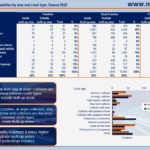
According to the Hellenic Statistical Authority (ELSTAT) road crash data for 2022, come off the road and at angle collisions are the most common crash types outside built-up areas. Moreover, pedestrian crashes, at angle collisions, side impact and rear end collisions are the most common crash types inside built-up areas. However, crash severity is almost 9 times higher outside built-up areas at pedestrian crashes. 






















































































































































































